CLEAR INTENTIONS
Jason Dhillon sets his sights on a supply chain career
Local procurement

AI in manufacturing
Optimizing data in supply chains
The Nissan Pathfinder Supply chain networks




Jason Dhillon sets his sights on a supply chain career
Local procurement

AI in manufacturing
Optimizing data in supply chains
The Nissan Pathfinder Supply chain networks



To stay competitive and get ahead, you need innovative, scalable and safe solutions. These solutions can help with better storage, distribution, fulfillment or any combination that can grow with your business as it adapts to change.
As your partner in facilities evolution, you can count on Konstant to transform your facilities. Collaborate with our team to optimize your facility today and evolve, anticipate, adapt and imagine the facility of your future.
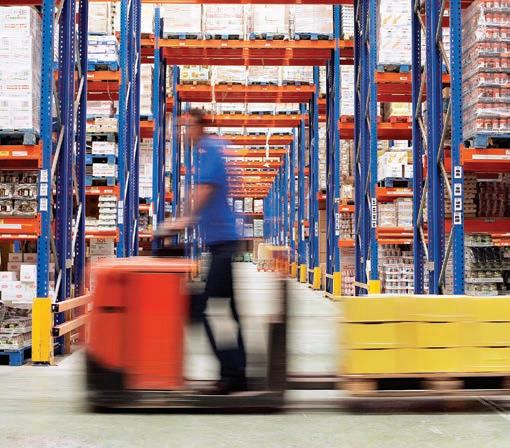
Get integrated logistics solutions: racks, shelving, trucks and robotics from our partners including Johnston Equipment and GNJ Automation.
Access comprehensive services for your project lifecycle, from planning to ongoing management with a skilled team ensuring quality at every step.
For more than 50 years, Konstant has served businesses across Canada, adapting our services to evolving facility management needs.
| 1-866-202-0064





































For the next few months, few geopolitical spectacles will attract as much attention as the US presidential election. All eyes will be on the race to the White House, with Republican former president Donald Trump yet again running for the top job. As of this writing, President Joe Biden has just stepped out of the race, with VP Kamala Harris as the frontrunning Democrat for the ballot on November 5.
Canada will, of course, watch the process closely. We share a 5,061km land border with the US – the world’s longest. That border handles over $2 billion in trade and thousands cross for business or pleasure.
And as Christian Sivière points out in his article about supply chain networks on page 20, roughly 77 per cent, or about three-quarters of Canada’s goods exports, go south of that border.
So, from a supply chain perspective the outcome of the election in the fall, and who exactly winds up President after the election, makes a big difference here.
We already know how disruptive the politics of our southern neighbours can be. Indeed, the first Trump presidency presented more than a few headaches for Canada regarding trade. Trump threatened to withdraw the US from the NAFTA. That resulted in the agreement’s renegotiation and rebirth as the Canada-United States-Mexico Agreement, or CUSMA (USMCA in the US).
The agreement is due to be renewed in 2026, roughly two years after the election. So, the winner of the US election will no doubt have a bearing on whether the trade agreement gets renegotiated once more, or if the potential to scrap it altogether is again raised.
In his article, Sivière also notes that Trump has threatened a 10 per cent flat tariff on all imports into the US, from all countries. Granted, the truth is that both Trump and the Democrats are fairly protectionist when it comes to trade. Yet Trump has signalled that he plans to ramp up the protectionism if re-elected. He may be less open to sitting at the negotiating table than a Democratic counterpart such as Harris.
What can Canada do? One course of action is to broaden our roster of trading partners. We’ve actually been trying to do this since at least the early 1970s, when then-Prime Minister Pierre Trudeau, the current PM’s father, dealt with similar threats from President Richard Nixon of slapping a 10 per cent tariff on goods entering the US
Trade deals such as the one with the EU, the Comprehensive Economic and Trade Agreement (CETA), at least signal progress in this regard, as over 90 per cent of the deal’s measures have already come into force.
The current Liberal government is also pushing a “Team Canada” approach to the spectre of a second Trump administration. Ottawa is ramping up diplomacy in the US, which is a good move regardless of who wins the election. After all, Harris seems to have similar views on trade as Biden and opposed the CUSMA deal as a senator.
Either way, this isn’t Canada’s first proverbial trade rodeo. And yet again, the stakes remain as high as ever in ensuring the smoothest trade relations possible with our Southern neighbours.

EDITOR
MICHAEL POWER 416-441-2085 x7 michael@supplypro.ca
PUBLISHER
FARIA AHMED 416-441-2085 x 5 faria@supplypro.ca
DESIGN
Art Direction ROY GAIOT Design Consultation BLVD AGENCY
EDITORIAL ADVISORY BOARD
LORI BENSON Procurement Compliance, L&D, Engagement and Knowledge Lead | Business Enablement, Ernst & Young LLP
THOMAS HUDEL Manager, Purchasing and AP, Esri Canada Ltd.
WAEL SAFWAT Procurement Director, Black & McDonald
SHERRY MARSHALL Senior Manager, Meetings, Travel & Card Service, PwC Management Services
KIRUBA SANKAR Director, Program Support, Purchasing and Materials Management— City of Toronto
JEFF RUSSELL Corporate Purchasing Manager & Inventory Manager, Miller Waste Systems Inc.
iQ BUSINESS MEDIA INC.
Vice President
STEVE WILSON 416-441-2085 x3 swilson@iqbusinessmedia.com
President & Executive Publisher ALEX PAPANOU
PUBLICATION MAIL AGREEMENT NO. 43096012 ISSN 1497-1569 (print); 1929-6479 (digital)
CIRCULATION
Mail: 126 Old Sheppard Ave, Toronto ON M2J 3L9
SUBSCRIPTION RATES
Published six times per year Canada: 1 Year $ 99.95 CDN
Outside Canada: 1 Year $ 172.95 USD Single price per copy $18.00 CDN
Opinions expressed in this magazine are not necessarily those of the editor or the publisher. No liability is assumed for errors or omissions. All advertising is subject to the publisher’s approval. Such approval does not imply any endorsement of the products or services advertised.
Publisher reserves the right to refuse advertising that does not meet the standards of the publication.
No part of the editorial content of this publication may be reprinted without the publisher’s written permission. © 2021 iQ Business Media Inc. All rights reserved. Printed in Canada.
I don’t know if you watched the debate between Donald Trump and Joe Biden on June 27 but my family and I did. The event, in its totality, was the funniest thing I’ve seen since I don’t know when.
There were multiple comic moments and as evidence let me quote. For example, there was an exchange about who was the better golfer and I’ll quote from the official CNN transcript. But I’ll have to do some editing (without taking anyone out of context). Trump: “I just won two club championships, not even senior, two regular club championships. To do that, you have to be quite smart…” Biden: “I got my handicap, which, when I was vice-president, down to a six.” Trump: “I’ve seen your swing, I know your swing … Let’s not act like children.” Biden: “You are a child.” I went to bed with a huge smile on my face.
But in the middle of the night, I woke up concerned. Everyone –including global money managers – saw what I did. What would it mean to the markets? We had enjoyed an extended period of time without a huge sell-off and some people thought that we were due. The realization that the next president of the United States of America and leader of the Free World would be one of these men would surely send a shock wave through the financial markets. When I got out of bed, I checked the S&P 500 futures. The market on 6/27 closed at 5,482, then
opened the next morning at 5,488. It was unchanged for all intents and purposes.
On one hand, this made no sense. Hadn’t everyone seen the debate? Yet on the other hand, it made all the sense in the world. Because the machine, and by this, I mean the economic machine is so robust, so powerful, that it doesn’t matter who occupies the Oval Office. There is a consensus in North America around some basic principles: A belief in property rights, the agreement that markets need regulation, and a bi-partisan understanding that the national debt doesn’t matter much, because whether it is a Democratic or Republican regime, all we’ve seen for the past six presidential terms (Bush twice, Obama twice, Trump, and Biden) are huge deficits year after year after year.
What did the late singer Meatloaf once say? Two out of three ain’t bad. But it’s not optimal, either. That’s because the single variable that could upset the economic apple cart is the amount of government debt on both sides of the 49th parallel. Canada’s debt to GDP currently stands at 70 per cent while in the US it is an astonishing 125 per cent.
Now, there is a good reason why the US can get away with this and it’s because the US dollar remains the world’s reserve currency. But as I’ve discussed before in this column, back in the summer of 2023, this doesn’t mean it will be the case forever. If there were ever widespread global abandonment of the Greenback, it would
mean a spiking of interest rates and a severe recession, if not depression.
And this is what should concern those who are responsible for public policy in North America. We’ve had eras before where the national debt soared. The postSecond World War era is a good example. Robust economic growth fixed the problem because it led to government revenues exceeding government expenditures and the resulting debt reduction. In the 1980s, under Ronald Reagan in the US and Pierre Trudeau and Brian Mulroney in Canada, debt swelled, only to be brought under control in the 1990s. But not through the particular virtue of government. Rather, it was by a technology boom which led to productivity gains that were unimaginable, that is, until they happened.
There’s a joke I heard recently that I absolutely love. What’s the difference between an optimist and a pessimist? The pessimist says, “things can’t get worse.” Meanwhile, the optimist says, “of course they can!”
I think we can apply this to North American sovereign debt. And don’t get me started on private borrowing. But for those of us that have children and care about their future, it is time to get our fiscal house in order, so when my son reaches the age of majority he won’t be exclaiming “what was wrong with my dad’s generation!?” SP

“The economic machine, is so robust so powerful, that it doesn’t matter who occupies the Oval Office.”
When speaking with operations, business, or supply students I often ask, “what is it that you wish to become or achieve when you’ve successfully completed your studies?” Many times, the immediate answer is “I want to be a professional!”
But have your ever asked yourself, “what exactly does it mean to be called a professional?”
Whether you’re studying in hopes of joining a profession, have just started your career journey, or are already a seasoned veteran, what is it exactly that makes you stand out in a positive way as a professional? Do the expectations of being a professional expand as your work experience or your educational credentials expand?
The answer is a lot deeper than simply studying or working in a chosen field and earning a paycheque. Being a professional is not the job that you do, it’s how well you do the job. Everyone’s job is different, so how do you gauge if you’re being successful and professional in what it is that you do?
It’s certainly not an exhaustive list, but here are seven fundamentals which you can develop to help build your foundation toward a successful and professional supply chain career.
Competency: It all starts with a detailed examination to determine what exactly your job entails, striving to do it to the very best of your ability while meeting, if not exceeding, the standards and expectations that matter. If you’re not aware of what your standards or expectations are, or should be, perhaps you should consult with your boss? These guidelines will form your
personal metrics to help you self monitor your daily key performance indicator (KPI) checklist.
Strive to be not only competent but proficient, qualified, and deeply skilled in your work, while being mindful to manage your conduct and execution. Don’t be afraid to ask for support when necessary either. Be proactive and collaborative, participating in opportunities to demonstrate your abilities and competency, while being a team player.
Make it easier by beginning your workday with an on-time (if not earlier) arrival, manage your time well, and be productive. Why be late and set an immediate bad example? Why not impress and inspire direct reports and coworkers? Being on time shows respect not only for your employer but those who you may mentor or interact with as part of your job. It also underscores your own self-respect, control, and competency.
Knowledge: Strive to master your job every day. Keep adding to what you know about your particular role and how you can make it better. Gain a strategic perspective by determining not only your role in the company, but how it interacts and can affect other individuals (like your boss) and other departments. Seek out how you specifically can add value to the company as a whole. Put your knowledge into action and diplomatically illustrate what you know, not for shameless self promotion, but to help yourself and those around you succeed.
Conscientiousness: True professionals plan and prioritize their work and hold themselves accountable for their words, thoughts, and
actions. Set your own high standards and show that you care about every aspect of your job. Be dependable. Be reliable.
Integrity: Often it may be hard, but your best job is when both your beliefs and behaviour are in sync and you’re honest not only to yourself, but with those you work with. Be true to your word, even if it means taking a harder path. Only then will people see you’re being genuine and a true professional. Ethics is everything.
Emotional Awareness: Manage your emotions and strive to have a perspective of other people’s feelings or biases in certain situations. Be diplomatic in showing your appreciation for their feelings with empathy and convey your thoughts on how to best solve a problem or proceed with an appropriate solution. At all costs, keep your thoughts and emotions professional while working under pressure. Perhaps when confronted with a situation, instead of an immediate “hey, that’s not my job,” maybe an affirming “perhaps I can help in some way?” is more appropriate in the long run.
Appropriateness: Endeavour to be self-aware and determine what might be the best (not just appropriate) way of conducting yourself in various situations. It’s not simply a matter of how you dress, your personal grooming, or your body language. Don’t forget, you’re representing your organization. It’s also about how you speak, write, the topics you choose to discuss, and how you behave when interacting with others.
Confidence: Take on new challenges and don’t worry about damaging your professional reputation

“True professionals plan and prioritize their work and hold themselves accountable for their words, thoughts, and actions.”
if things go wrong. It’s a better path toward being seen as a leader and a successful go-to person in the attempt, than someone who fails by declining the invitation of a new challenge. Not only will it boost your confidence, but it also makes it easier for you to influence, reassure and motivate others. SP
Amazon has replaced 95 per cent of the plastic air pillows from its North American delivery packaging with paper filler, working toward full removal by the end of the year. This will be Amazon’s largest plastic packaging reduction effort in North America and will avoid nearly 15 billion plastic air pillows annually.
Last year, Amazon announced an automated fulfillment centre in Ohio to eliminate plastic delivery packaging, including the transition from plastic air pillows to paper filler. This allowed them to transition to paper filler for 95 per cent of shipments in less than a year. To achieve this, the company collaborated with suppliers to source paper filler made from 100 per cent recycled content, while coordinating the transition across hundreds of fulfillment centres.
Through testing of paper filler, Amazon discovered that it offers the same or better product protection than plastic air pillows. The paper filler is also curbside recyclable and made from 100 per cent recycled content.
Ottawa is investing $76 million to help York Region build an electric bus fleet. The region, just north of Toronto, will get 180 zero-emission buses, 91 battery electric chargers, and 14 on-route chargers.
Provided through the federal government’s Zero Emission Transit Fund, the electric buses require less maintenance than traditional diesel buses, the government said.
The vehicles are expected to reduce emissions by about 15,982 tonnes annually. York Region’s three existing transit facilities that will house the zero-emission buses will also get solar power and battery energy storage systems.
The project is also supported by a $136-million loan by the Canada Infrastructure Bank.
Purolator has released its sixth annual Sustainability Report, titled Going the Extra Mile. The report outlines the company’s 2023 achievements in its commitment to people, communities and the planet, and details how Purolator is advancing its goal to be an industry leader in corporate sustainability.
Among its sustainability achievements in 2023, Purolator saw an 11 per cent reduction in absolute Scope 1 and Scope 2 emissions and transitioned over 500,000 litres of fuel from diesel to renewable diesel. It also reduced emissions from
electricity use by 70 per cent through renewable sources. The company exceeded its 2030 landfill waste diversion goal, reaching a 72 per cent diversion rate from landfills seven years ahead of schedule.
Other highlights of the report include: Purolator reported, for the first time, against the Task Force on Climaterelated Financial Disclosures (TCFD).
Achieved a 48 per cent reduction in lost-time injury frequency. Developed a DEI governance framework and published an Accessibility Plan.
The Montreal Port Authority (MPA) has completed its project to optimize rail capacity. Phased in over three years at a cost of $62.4 million, the project extends from Bourbonnière Avenue to Panet Street, near the Jacques-Cartier Bridge, and will increase the port’s rail capacity.
About 45 per cent of the port’s cargo is carried by rail at a rate of 60 to 80 trains per week. The project aims to strengthen and optimize this
senior VP
Dematic has named Michael Oren as senior vice-president of sales for the Americas region. Oren will join Dematic at its Americas headquarters in Grand Rapids, Michigan to lead a sales team of about 95 people. He will be responsible for developing the sales strategy, including nurturing and retaining accounts, driving company growth initiatives, and building relationships with strategic partners.
Oren joins Dematic from Xerox where he served as vice-president of global services. In this role, Oren oversaw global software and services, strategy, business development, partnerships, and more. Over the course of his 20-year tenure at Xerox, Oren held several additional leadership positions, including US vice-president enterprise services, vice-president of global sales, and vice-president of central and eastern US sales.
Oren completed executive master’s courses at the University of Navarra, Harvard Business School, and Stanford University, and he received his bachelor’s degree in marketing and social psychology from Miami University in Ohio.
strategic infrastructure at the hub of Greater Montreal’s supply chain. The project features: Two tracks totalling 6km of additional track and six switches to serve the 14 terminals.
Retaining walls totalling over 1km in length.
Relocation of the Port Road and all related infrastructure (sewer, water supply, power, and telecom networks).

BY JACOB STOLLER
“Do they want command-and-control where their managers are sheriffs who monitor keystrokes of the remote worker, or do they want collaboration and teamwork, where their managers are mentors.”
One of the many outcomes of the COVID-19 pandemic has been a debate about whether the practice of allowing employees to work from home should be permanent, or whether companies should revert to a more traditional model.
Much of that question revolves around productivity – are remote workers, who might be subject to the various distractions of the home, as productive as they would be in the office? Are they more productive because they are freed from the distractions that often come with office environments?
In asking these questions, people often assume that if we maintain the productivity of each individual in a remote scenario, then the company will perform as well as an in-person environment.
There are numerous examples where individual productivity doesn’t necessarily correspond with company performance. Take for example a sales rep for an HVAC contractor who, encouraged by an incentive to make the
quarterly numbers, brings in a large order, perhaps with some modifications and special discounts to close the deal. The sales rep is then judged to have had a productive quarter.
The spike in volume, however, along with the concessions to close the deal, overwhelms installation staff in the service department, forcing them to incur the expenses of temporary staff or overtime, and to expend extra hours accommodating the modifications. Therefore, while sales department productivity is higher, that effort might have caused the service department productivity to drop.
The principle applies in any scenario where there are handoffs. A procurement person might score high on individual productivity for slashing material costs, but if there are quality issues in the materials, or if the volume of the order causes storage problems and clutter in the plant, that work could be reducing the productivity of the production department.
The lesson here is that in terms of creating value for customers, the only productivity gains that matter are increases in productivity of the entire team that the customer depends on for quality and on-time delivery. From that perspective, the result is not attributable to an individual, but the team.
Team productivity, however, doesn’t just happen because people are in the office. The lack of coordination that causes problems with remote workers are just as counterproductive onsite.
“A useful operational definition of a team is the collaborative and coordinated efforts of people working together in an atmosphere of voluntary trust,” says Kelly Allan, a Deming Practitioner and principal of Kelly Allan Associates, Ltd. “That’s what makes it a team sport. If you don’t have that, you don’t have a team.”
Before they start measuring, therefore, leaders must ask some fundamental questions. “Leaders get to decide how they want to manage their companies,” says Allan.
Many companies are sitting on the fence on this issue, aspiring to build a team culture while engaging in practices that defeat it. Tools such as apps that track mouse activity and keystrokes, therefore, while effective at measuring individual productivity, are counterproductive with regard to creating an environment where team productivity can thrive. Much of this has to do with trust.
“If you look at the data from companies that track things like employee theft, you’ll find that about 5 per cent of employees are always looking to take advantage of their employers,” says Allan. “But monitoring keystrokes for the remaining 95 per cent is counterproductive, because in doing that, I’ve upset them and lost their respect. Furthermore, if you think that the number of employees who are cheating you is a lot higher than 5 per cent, then I would suggest to you that there’s opportunity for improving the culture that has been set by management – and with it, profitability.”
The statistics suggest that many companies have yet to address this issue. According to a 2023 Gallup survey, only 30 per cent of employees are actively engaged in their work, while 17 per cent are actively disengaged.
Creating a collaborative team culture involves a significant departure from the conventional command-and-control management approach that is taught in business schools. This fundamentally changes the role of managers – instead of being enforcers who tell workers what to do, they become coaches and mentors who help their people succeed. This alternative approach is the cornerstone of Lean management and of the closely related Deming principles that Allan applies when he works with clients. Essential to this approach is
making sure that the purpose of the company is clearly understood.
“Employees need to feel connected to the purpose and understand how their jobs contribute to it,” says the 2024 Global Culture Report from the O.C. Tanner Institute, noting that purpose needs to be other than profits, but how the organization makes a difference in the world.
“Once they do, their work takes on meaning. Organizations should clearly articulate the connection between work and purpose.”
A Deming approach that Allan uses with his clients is the dismantling of incentive systems that reward employees for results that could be harmful to other team members. In fact, one of Allan’s clients, an Ohio based HVAC contractor, achieved extraordinary results by removing the traditional commission-based sales incentive system and moving to a systemic approach that reflected how the var-
“A strong supplier will also offer additional support such as a product performance reporting and service level agreements (SLA).”
ious team members interact and depend on each other.
“What this did is take away any structural hurdles to collaboration between the different siloed sales groups,” says Air Force One CEO Greg Guy. “And the outcome was fascinating. All of a sudden, collaboration, team spirit, and sales productivity increased dramatically. We were selling
better deals to better clients that were healthier for the overall enterprise.”
With a strong collaborative culture in place, the question of whether employees are working in the office or at home becomes irrelevant. “Some of our clients who are advanced in applying the Deming principles allow their employees to work where they want and when they want,” says Allan. “The organization has certain things that have to get done, and these people know that – and they make it happen. Additionally, when people are finding joy in their work, people do more work.” SP

is the author of the upcoming book Productivity Reimagined, on which this article is based, to be released October 14. His website is www. jacobstoller.com.
24_006371_Supply_Professional_AUG_CN Mod: July 3, 2024 8:52 AM Print: 07/12/24 page 1 v2.5
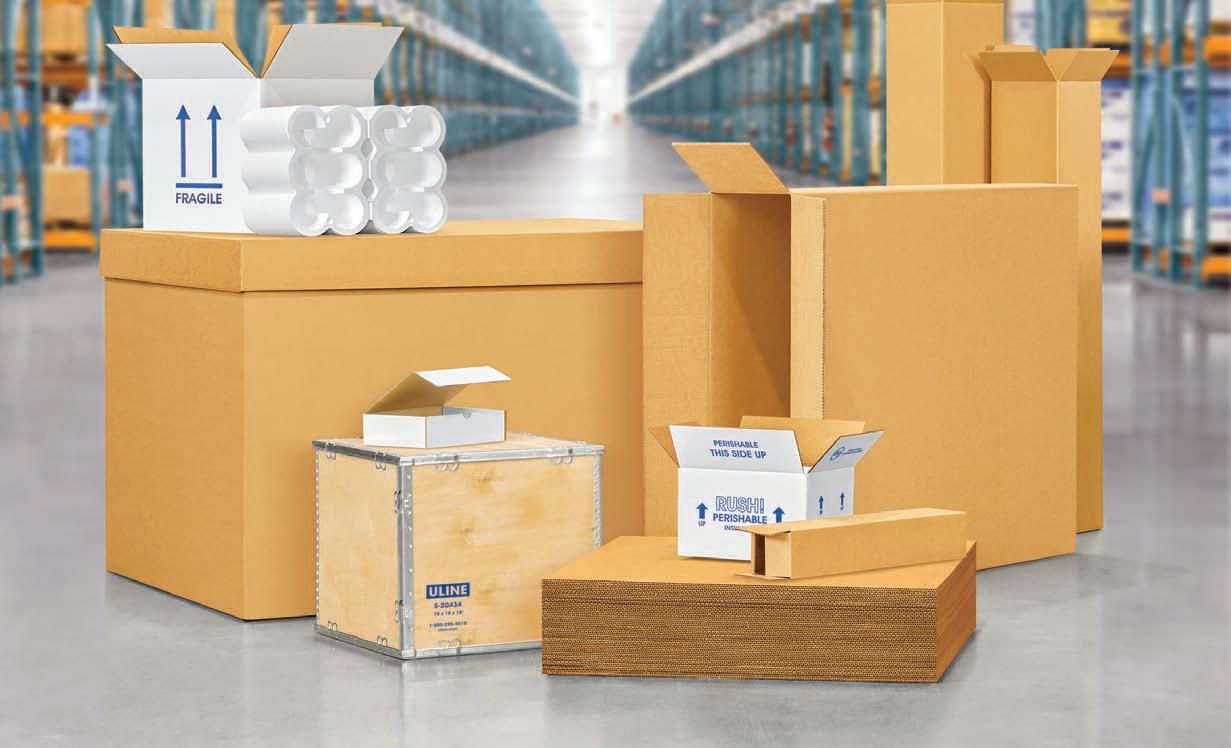
ORDER BY 6 PM FOR SAME DAY SHIPPING

BY MICHAEL POWER
It’s a common story for those in the supply chain profession: they stumble into it as if by accident from other professions, like finance or operations. Especially in the past, practitioners rarely chose the field with the intention of making it their career.
That’s changing. In recent years, supply chain has gained exposure and risen in popularity as a career option. More than ever, recent graduates and young professionals consider supply chain as they survey the job market.
One such young professional is Jason Dhillon, vice-president of supply chain at ITWAL Limited. Uniquely, Dhillon’s supply chain journey began when he was in school. In 2007, he completed an Honours Bachelor of Business Administration (BBA) at Wilfred Laurier University in Waterloo, Ontario, with a major in supply chain management. At the time, there was less interest in supply chain, as it was in the early stages of becoming an academic field. Of 650 graduates in the BBA program that year, only 18 went into supply chain.
“I remember heading into our last year of my graduation,” Dhillon recalls. “That’s when they came out and said ‘there’s a major in supply chain management.’ I thought I want-
ed to do accounting, finance, HR, marketing –you name it. And I was like, ‘you know what? This is different, let’s try it out.’”
Supply chain positions were scarce at the time, so Dhillon decided on post-graduate studies. While searching for a program, he discovered the program run by what is now the National Institute of Supply Chain Leaders (NISCL) and the Certified Supply Chain Leader designation (formerly the Supply Chain Management Professional, or SCMP, designation). The designation’s instruction was at Humber College in Toronto, the closest location to Brampton, where he lived.
Dhillon enrolled and found himself among the youngest participants in the program. Yet he was impressed with the calibre of the other students and the organizations they worked for – Canadian Tire, Bell Canada, CBC, and Maple Leaf Foods, to name a few.
Dhillon stuck with the program and began applying for jobs. He eventually applied for a procurement manager position at The International Centre – a 548,000-square-foot conference centre adjacent Toronto’s Pearson International Airport. The role, which Dhillon accepted, was a food and beverage position.
“It was great experience; they let me cover everything,” he says. “Chemicals, uniforms, food and beverage, produce, meats, dairies, what have you.”
After spending almost two years in that position, a buyer role opened at Tim Hortons’ head office in Oakville, Ontario. Dhillon had recently gotten married and was looking for a larger position. Originally, the position was a 12-month contract, although the company made it a permanent job after meeting him.
“They were pretty impressed with how much I covered,” he recalls. “Even though I came from a smaller company and that was my first foray, you could say, into tier one.”
Dhillon enjoyed a lot of autonomy and scope at the company. Starting in early 2013, he spent two years working several strategic projects at Tim Hortons as a buyer for restaurant equipment and “smallwares,” which encompasses hundreds of different products like utensils, cookware, glassware and so on. “It may not sound like a lot, but it was millions and millions of dollars, only because it’s Tim Hortons,” he says.
Another firm eventually acquired Tim Hortons, and Dhillon found himself laid off through redundancies. The next day, Maple Leaf Foods called him, and he eventually accepted a manager role at the company in 2015. The position again had a broad scope, with Dhillon involved in procurement, customer service, logistics, and other areas.
Dhillon spent the next five years helping to develop and roll out the capital purchasing process for the company’s 20-plus manufacturing sites across Canada. He eventually focused on packaging categories, with a mandate to capture cost savings. At that task, he was consistently the lead contributor on a team of about 14 members.
“I decided to leave Maple Leaf Foods due to a new opportunity at my current employer, ITWAL, where I was given a wide band of responsibilities that included managing a procurement team, a customer service team, and being responsible for third-party logistics and all systems data management via our legacy ERP system,” Dhillon says.
ITWAL has a national network of independent, diversified retail and foodservice wholesale distributors, and provides a distributor alternative. Its member distributors provide a full range of products supporting business operators including convenience stores, drug stores, gas bars, independent grocers, foodservice restaurants, and others.
Soon after he joined the organization in late 2019, the COVID-19 pandemic hit full force. Dhillon was only a few months into the role and hadn’t yet completed a full 12-month cycle that
would have better informed him of how to manage different promotions and seasons. He found himself working from home with a laptop. That was a nerve-wracking time, he notes, as he worked to get up to speed on what the job entails.
Dhillon has now had several years to learn the position. Effectively, he is responsible for all operations within ITWAL’s distribution business. And like many people in the field, each day can offer a new challenge or opportunity he must address. That said, his days do have some routine. The first set of reports he looks at is the outbound fill rates that typically highlight any chronic issues that need to be addressed. That’s usually followed by dealing with issues related to customer service, where requests must be prioritized.
Then, most days, there are reviews of existing or new vendor programs along with new SKU listing opportunities to ensure the organization is looking at all cost drivers and potential for growth. His team is also constantly reviewing and scrutinizing logistics costs, with Dhillon ultimately approving those costs to ship product downstream.
He has also recently taken over responsibility for warehouse operations and building maintenance. It’s an exciting opportunity to put operations under one team and allow cross-functional team members to improve how they work together, Dhillon notes, as they all now report to him.
Dhillon has five major pillars regarding his responsibilities: procurement; customer service; logistics; he has a system support analyst who updates the organization’s ERP system; and the recently added warehouse responsibilities. Managing those pillars is challenging, as Dhillon must divide his time between all areas he’s responsible for. “I literally have people used to having ‘X’ amount of my time in my existing departments,” he says. “Now that time is shorter because I have to spend more time in the warehouse. And I have to make sure that the distribution manager has a lot of my time because I support him. So yes, there’s a lot of things that I’ve got to cover.”
Dhillon credits his education and professional designation for many of the skills he uses on the job. He has put to use much of what he learned during his education over the years, he notes. “That program was a catalyst for everything that’s happening to me right now, along with hard work and dedication,” he says of his NISCL designation.
Dhillon is especially proud of several career milestones, including being a project lead on an outsourcing US distribution project at Tim Hortons. He also developed and trained for

Capital Purchasing Process and was the top cost savings contributor for packaging categories at Maple Leaf Foods. He is also proud of taking on a diverse set of responsibilities at his current position at ITWAL.
Yet the part of his career that stands out the most involves people. In the past, when Dhillon was told someone on his team wasn’t suited to a role, he’s been able to work with them so that they ultimately excel. Having the right people in the right positions allows him to focus on more strategic initiatives.
“The moments I am most proud of are being part of hiring and developing key team mem-
bers and seeing them progress within their careers,” Dhillon says. “Early in my career, I was given a staff member the organization was thinking to get rid of. However, I was able to work with this person to where they eventually won the Employee of the Year Award. Also, I have hired some fantastic team members who either continue to excel in their
roles, or most recently where one of our buyers got promoted to procurement manager.”
Another example involves a long-time ITWAL employee – one of Dhillon’s direct reports – who was recently promoted to customer service team lead. The organization has also named the employee a 2024 Star Women in Convenience, an internal award.
During his career, Dhillon has sometimes had to manage people significantly older than him. Those employees have tended to be experienced and well-versed in what they do. To gain their respect and have them perform at their best, Dhillon has focused on putting them in the right positions, empowering them, and being a good listener. When you remove barriers and provide high-level guidance, people often perform at their best.
“Sometimes it works out great, and sometimes I get some pushback,” Dhillon notes. “But for the most part, I got the engagement that I got because they actually feel there’s some value I’m bringing to the organization. I would only have gotten to the level that I did by getting people that are really good at their jobs that are reporting to me to be successful.”
Dhillon’s dedication to the field has paid off through recognition. While at Maple Leaf Foods, on two separate occasions, he was one of 100 employees out of thousands nominated for top employee. Dhillon considers it an honour to even have been nominated for the position, which requires a sponsor along with endorsements from colleagues.
“Depending on what your employer wants from you, what their objectives are, and where they want to go, that’s what you focus on,” he notes. “That can be cost savings, that can be just bringing efficiency, that could be fill rates, it can be anything. Supply chain covers so much and if you’re really good at it, you can move from logistics to procurement, to warehouse management, to a systems analyst. Typically, if you’ve got good adaptability, a good resume, it should show you’re good at a lot of different things instead of being a one trick pony.”
That diversity has become more important since the COVID-19 pandemic. Since 2020, says Dhillon, supply chain professionals have had to adapt, since some old processes don’t always work as they once did. Pre-pandemic, large organizations had an easier time negotiating with vendors for lower costs. But due to post-pandemic supply challenges, that strategy has largely changed to working with suppliers as partners to get products.
“It was more of a big shift to supply,” Dhillon says of the pandemic era. “We’ve got to get supply. We’ve got to get product for the customer.
“The moments I am most proud of are being part of hiring and developing key team members and seeing them progress within their careers.”
If that supplier came back and said ‘look, the prices went up 30 per cent,’ you don’t have that much leverage to say anything because you have a business to run. Whether you’re running a manufacturing line, a restaurant business, any of the distribution businesses, it didn’t matter. Everybody wanted product, and it was so hard to get product. So, the biggest shift for procurement, especially, and supply chain, was, where is product?”
This led to scrutiny of some supply chain approaches, such as just-in-time, Dhillon says. Organizations had to increase safety stock levels to offset supply disruptions. Adaptability is key as supply chains continue to deal with these disruptions.
Proper and upfront communication is paramount in setting expectations, Dhillon stresses. Keeping people aware of challenges, and that everyone must be patient, helps organizations get ahead of the narrative amid disruptions. Conversely, not communicating leads to frustrated customers wondering where their product is.
“That disruption that’s been occurring and, quite honestly, it’s not completely gone yet, is what I’ve found has been the biggest challenge that people still to this day haven’t fully gotten over,” Dhillon says. “It’s learning that the world is different now and we have to adapt.”
As vice-president of supply chain, and having recently taken on responsibility for warehouse operations, Dhillon says he’ll spend the next several months identifying opportunities for collaboration between procurement, customer service, logistics, warehousing, and the data systems teams. Those functions are interconnected, and ultimately report to him, so he’s excited to determine the best overall metrics and results for the business – which will keep him busy for some time.
Dhillon also stays abreast of industry developments. He follows what’s going on in the convenience store and gas station sectors, for example, as those businesses represent a significant part of his organization’s customer base.
“As far as recommitting to any further education, it’s probably just maintenance,” he says of his future plans. “I’m at the point in my career where I probably don’t need to do something like an MBA, quite frankly. It probably wouldn’t give too much value to me. Not saying it’s not
valuable, of course it is, but the ROI probably wouldn’t be there, considering where I’m at.”
Dhillon and his wife have two young daughters, so he devotes much of his spare time to family and decompressing at home. He works out at home and tries to find time to take up golf. He and his family have been getting into travel recently and went to Jamaica and, more recently, Italy.
“But I’m a pretty private person and I spend most of my time at home and I try to do something with the kids,” he says.
During his career, Dhillon has worked for both large and small organizations. That mix has given him an interesting perspective on supply chain, he says, and both have pros and cons. A smaller company, for example, requires skill at fostering relationships. It’s easier to get lost in the shuffle if you haven’t built those relationships. You must also hone negotiation skills, helping to ensure customers get the products they need. Taking that experience and skill to a larger company can help lead to success, Dhillon says.
“But I will say, having that differentiation in experience and company sizes has been absolutely instrumental to my success,” he says. “I can go into procurement, supply chain, what have you. It’s something people don’t talk about often.”
For supply chain professionals new to the field, Dhillon recommends exercising patience. Don’t try to skip career steps. Many people want to go quickly from an entry-level position, to manager, to director, and so forth. But time is the best teacher, Dhillon says.
“I had a boss one time who told me, ‘Jason, I believe if you haven’t made any mistakes, you’ve never learned anything.’ Is that ever true. Sometimes people want to have that pristine resume and that track record. And if you have this perfect track record, I can bet you everything, you didn’t push it.”
For more experienced professionals, nothing beats further education to advance one’s career. Investing in education, then combining that learning with existing skills and experience, can make an employee highly valuable to an organization.
Finally, remember that no career advances in a straight line, Dhillon says. There will be peaks and valleys. It’s easy to feel that you’re on the wrong track or moving backwards. But stick with a goal, and you will eventually arrive.
“People think they want to progress their career,” Dhillon says. “What I’m trying to say is that it’s not a straight line. It’s almost like a jagged line. But looking at the long-term trend, it usually goes in one direction if you’re willing to move around and take some risks.” SP
BY SARAVANAN PARISUTHAM
The fashion industry, which has substantial environmental and social impact across communities, is becoming more sustainable, circular, and fair. Manufacturers and retailers are increasingly setting ambitious ESG targets, although the path to those targets isn’t immediately clear. Change requires knowing what’s going on in the supply chain in detail, so brands understand where to focus efforts for improvement and measure them. They’re also looking to prove to customers and regulators that their products are made with responsible materials and good working conditions, but need evidence to back up their claims to avoid the risk of greenwashing or losing customer confidence. As a result, supply chain transparency and product traceability – knowing your full supply
chain and how each product has been made – becomes more important than ever.
The ideal solution is a fully digitized supply chain with easily trackable and shareable records between third parties, where updated, validated data is always available. However, few organizations are set up to do so – and the industry isn’t either (though they will be in the future, this is a work in progress). A large part of the supply chain, and in particular the lower tiers, are relying on offline documents, meeting requests for information with emails, Excel sheets and pdfs.
While some tier 1 and tier 2 companies are adapting their reporting and records to share data and enhance efficiency, others need help to transition and move toward top-to-bottom traceability. By embracing a hybrid solution that combines existing digital records with processes to transcribe and digitize physical records, forward-thinking businesses can improve efficiency immediately instead of waiting for the creation of an industry-wide, fully digital solution or standard.
For now, if companies set ambitious transparency or compliance goals without knowing exactly how to meet them, a hybrid technological approach becomes critical to bridge this data gap and effectively manage the transition.
During this transitional phase, in which physical and digital records are common, the hybrid model for supply chain traceability combines real-time data collection for digital records with processes to transfer hard-copy records into digital format. This process has often been done through data entry, but more advanced solutions leveraging AI and optical character recognition (OCR) are streamlining a lot of this work. As long as data collection processes can vary from one part of a supply chain to another, with some being highly digitized and others largely paper-based, attempts at
“Hybrid traceability solutions offer faster, easier access to more data than early digitalonly solutions.”

all-digital solutions won’t optimize workflows and could lock businesses into processes that make it more difficult to share data.
Some solution providers promote fully digital solutions, but even the most advanced offerings cannot yet eliminate or automate the analog or physical records in most supply chains. That requires connecting every actor to the system. Hybrid traceability solutions offer faster, easier access to more data than early digital-only solutions, resulting in time savings for compliance needs or audits.
This makes the hybrid approach ideal for the near- and medium-term, maximizing use of available tools while avoiding investment in unproven systems or workflows that may become obsolete or be incompatible with industry-driven standards. Once a fully digital supply chain becomes available, brands can optimize their supply chains further with readily searchable real-time product databases; automated summaries of on-time shipments; historical pricing or volume changes; and more.
But that requires industry cooperation. An optimized, end-to-end digital traceability system must be open-source to enable maximum efficiency and applicability, and an open-source system requires access to third-party records with buy-in from the entire industry. Every company has the right to protect and silo its own data, but those choosing a protectionist approach may end up with higher compliance costs and miss out on the ancillary benefits of a shared data ecosystem.
Before an open-source, all-digital solution can come to fruition, we must educate industry players about the benefits of a digital system to empower streamlined supply chain
transparency and traceability. It will also be vital to discuss the approach to data privacy and security, as collaboration requires the trust and assurance of participants to ensure reliability and fair use. Until full digitization becomes standard across the industry, we expect a range of data sharing permissions to persist among different levels of the supply chain, such as small vendors that largely rely on paper and major corporations that are already heavily digitized. Therefore, making data migration easy will be necessary for any future open-source solution. Hybrid solutions that enable direct control over data, including migration assistance, can help companies prepare to leverage innovations or new platforms.
An industry-wide solution would rely on an independent mediator or “clearinghouse” that sets and upholds universal data standards and processes, while providing a centralized location for the open-source data to be shared and verified or certified. But as mentioned, this will take some time.
Attitudes about collaboration and data sharing are evolving with more solution providers combining efforts and streamlining centralized record keeping to aid access and efficiency. This cooperation is vital to help us move from reactive to proactive data collection to manage supply chain risk, compliance and impact. SP
BY NOELLE STAPINSKY
In today’s data-driven landscape, the challenge for supply chain professionals often lies not in the scarcity of data, but in the ability to harness the full potential of diverse, unconsolidated data streams. And there is certainly no lack of sophisticated tools to measure the efficiency of a fulfillment operation, monitor equipment, and evaluate supplier reliability. However, according to Brett Webster, director of product management at Dematic, the true power of these analytics is frequently untapped due to the compartmentalization of systems.
“By integrating these disparate data sources, we unlock a comprehensive perspective, enabling more informed decision making. Such integration doesn’t just add value; it transforms the entire approach to strategic business intelligence,” says Webster.
Supply chain management is, of course, heavily tied to forecasting. It might take days or even weeks to adapt to a shift in demand or supply, and anticipating those changes is the key to minimizing inventory holding costs while also reducing possible supply disruptions.
“The use of centralized supply chain collaboration systems is increasingly popular. These systems provide tools to monitor suppliers, transportation providers, and enterprise-scale
operations, including order distribution and global inventory management,” says Webster. “They leverage the cloud to support large-scale data and enable integrations that offer automated data sharing and shared benefits. It’s critical for supply chain management tools to consider all available information, including the current state of the enterprise, the weather, current trends, and global events that can all play a significant role.”
The Internet of Things (IoT) is a significant source of data across the entire supply chain. Webster says that use cases of such data include cold-chain and environment tracking, predictive maintenance on warehouse or fleet assets to increase reliability, location tracking and more. “IoT also plays a crucial role in sustainability, such as monitoring power consumption and tracking noise levels in work environments,” he adds.
Digging into the management of fleet assets and transportation offers up a plethora of data that can streamline the de-risking of supply disruptions. Every shipment generates data, such as common delivery locations, delivery times, frequent order times and other data points that businesses can consider in a number
of applications, according to Mingshu Bates, chief analytics officer for AFS Logistics.
“Tools and technologies, including transportation management systems (TMS) can help shippers capture these critical metrics,” says Bates. “As a third-party logistics (3PL) provider and one of the founders of the freight audit and payment (FAP) industries, the more than $39 billion in annual transportation spend visibility we have across multiple modes flows into our systems from over 1,800 customers of all sizes and industries. Such transportation data can be extremely informative in structuring and optimizing logistics networks to help control costs and improve service levels.”
This access to such an enormous amount of data gives the AFS team strategic insights about rate levels for parcels, less-than-truckload and truckload modes that help its customers negotiate contracts and discounts with carriers from a more informed position and realize cost-saving opportunities by shifting between services or modes.
“To give a real-world example, an industrial fastener manufacturer came to us for help aligning their distribution centre locations with customer locations. We conducted a data analysis of their network and found their network
featured redundant supply lanes and low productivity,” says Bates. “After presenting multiple proofs of concept, we recommended they reduce their distribution centres (DCs) network from three DCs to two, which enabled the manufacturer to still offer a two-day transit time for 97 per cent of their shipments, with a 13 per cent reduction in their carrier spend.”
Indeed, data can be used to diagnose and help protect against supply chain disruption risks in a variety of ways, including increasing optionality and planning.
“In recent years, many businesses have been looking to add geographic and carrier diversity to their networks to avoid too much of a reliance on a single location or provider in the event of severe weather, geopolitical tensions, instability, business specific issues or other disruptions,” says Bates. “As a general rule, operations with multiple DCs should locate their facilities at least 800 kilometres away from one another to minimize the risk of a single geographically isolated disruption from impacting multiple facilities. Using data to understand the geographic distribution of not only customers, but critical shippers, can help businesses to distribute their inventory more carefully, and also temporarily adjust if needed.”
State-of-the-art TMS technologies available on the market today are helping manage everyday freight tasks automatically, from accessing invoices and creating bill of lading documents to tracking shipments and filing claims. And some of these systems can be fully integrated with enterprise resource planning (ERP) systems. This allows for real-time updates to help streamline processes and capture critical information.
“More advanced technology generally enables greater data capture and visibility, but that is only the first step. Large volumes of data do not automatically translate to meaningful insights. In fact, many find themselves in a ‘data rich, insight light’ situation, where their business generates a lot of data, but that data can be complex and cryptic, so it can be difficult to understand what exactly it means and how they can use it for their business,” says Bates. “The other common challenge we encounter among shippers is the data cleansing process, including standardization and normalization. This is a very important part that is often overlooked, but it serves as a foundation for any analysis. Working with a trusted partner whose reporting is built on a robust data cleansing process and who can help translate all of that data into clear, actionable insights is key.”
Webster agrees, “Data analytics within the warehouse and supply chain can provide significant benefits, but it’s important to properly
“More advanced technology generally enables greater data capture and visibility, but that is only the first step.”
understand your business goals before focusing on specific areas. It’s also critical to ensure you have the right data, and that it’s timely and accurate enough for decision-making. The best advice is also the simplest: think big and act small. Have a big plan, but focus on getting quick results and incrementally build out the use cases you are most interested in.” SP




































BY LARRY BERGLUND
Sustainability in supply chains often involves deliberations on buying from local businesses or buying Canadian-made goods and services. Yet defining local is subjective and mired in ambiguity. Initially, the purpose of a local business was to offer unique products or services that weren’t readily available and for which there was a demand. From a supply chain sourcing perspective, the problem is that local is often affected by loyalties to small business owners with personal ties to the buying entity. There are emotional attachments based on familiarity with local businesses. Consumer buying habits and retail sales are rooted in being identified as local. Trade agreements do not allow for local preferences.
Smaller, established communities want to support local or independent businesses but may do so based on an address – not usually an objective decision. Larger rural areas are less concerned with tough negotiations with their local businesses on goods and services than their urban counterparts. Many local purchases by a town are not large budget items
and can be met by a local supplier. Small budget items, but big impacts for local businesses.
In smaller locales, supply contracts are intended to support local employment and are often influenced by elected officials. The supply of fleet vehicles or construction equipment may come from a local distributor, but the brand of equipment itself could seldom be referred to as local. Smaller communities are trying to ensure a local business presence and not default to buying from a lower-cost, multinational corporation (MNC).
Smaller, established communities with only a few service providers can be in a conflict of interest when tendering for goods or services. For businesses buying goods and services, there needs to be a strategy which considers small and medium enterprises (SMEs), social enterprises (SEs), and MNCs. Value for money could be compromised to support local businesses where a bias favours a small owner or contractor. This practice has led to unfair advantages for local suppliers and unethical/illegal procurement practices by elected officials when awarding contracts.
To add to the confusion around local is the definitions of what is a city, a village, a town, a hamlet, a resort community, a district, a regional district, a neighbourhood, a rural municipality, an urban municipality, an unincorporated settlement, or a region. Canada also has multiple definitions for businesses. A brief literature search found 23 definitions for various types of businesses, including local.
Buyers can take an all-or-nothing approach. This involves buying as much as possible from the lowest-cost source, regardless of locale, as long as the seller meets the specifications – strictly price-based. Other buyers, for resiliency, will buy a certain percentage at the lowest cost and the balance from one or more other suppliers to avoid shortages.
Running a competitive bid with a couple of local suppliers is not going to achieve a competitive out-
come. If one supplier fails, there is lesser competition in the long term. Running a competitive bid without a sufficient number of bidders could invite collusion. Small towns might only be 30 minutes apart, so how could officials objectively decide which is more local?
It is common for larger buying organizations to award long-term contracts for the majority of their operational needs, wherever possible. Setting aside the need to have flexible or resilient sources, reducing the cost of goods and services is a prime motivator for buying organizations. Where we see this strategy being tempered, is where there is a concern that economic development and social interests are an integral part of an organization’s purpose for being in business.
MNCs or other large employers located in smaller communities do provide opportunities to contribute to the local social and economic development. The large employers can ensure they source locally produced goods or services. Maintenance, operating, and repair supplies are ideal to source from local distributors, and repair shops to complement supply contracts. These larger buyers can unbundle their requirements to target local SMEs, SEs, or Indigenous suppliers. Many suppliers are able to support a percentage of locally made goods as part of a larger supply contract. Municipal entities, as well as school districts, universities and hospitals, can direct a percentage of their supplies to local companies.
Resiliency requires a strategy that is inclusive of SMEs and SEs to complement conventional supply chains. Hospitals and universities buy tonnes of food. Making fresh produce one of the criteria in a contract favours local supply and does not compromise trade agreement obligations. Stating that service response times in a contract must be within an hour will draw more local companies. Tracking the spend allocated to local is information stakeholders like to know.
Unbundling larger contracts and having the aggregate demand met through several smaller contracts,


supports economic and social development interests. Unbundling intentionally creates more opportunities for businesses to participate economically. Unbundling can encourage larger organizations to partner with local SMEs and SEs to provide ancillary services in the value chain. The economic multiplier effect can measure the incremental shifts of unbundling demands as opposed to the allor-nothing supply models.
In general, buying local is aimed at supporting family-owned farms, local produce, locally made artisanal items, small lots of fabricated goods, or having requisite services provided by local trades along with apprenticeship programs. A local SME can’t provide larger components of capital equipment or infrastructure projects. However, SMEs and SEs should be able to participate in these works, although they will seldom be the major supplier, contractor, or investor.
I am advocating for conscientious procurement decisions in the retail, as well as public and private, sectors. Knowing how buying goods and services locally impacts a community is just as important as fiscal responsibility. When spending by P-card, think local first. Enjoy an MNC coffee and remember that a local coffee shop at one time inspired an MNC investment. SP








ASI OFFERS THE ONLY METAL PARTITIONS WHERE PRIVACY IS ENGINEERED INTO THE DESIGN. DON’T SETTLE FOR AN ADD-ON PRIVACY STRIP AS AN AFTERTHOUGHT. AT ASI, PRIVACY ISN’T OPTIONAL. IT IS OUR STANDARD.


ASI’s proprietary, Integrated Privacy ™ partitions are engineered with built-in privacy and manufactured as one color matched unit, o ering complete privacy without the need for any retrofitted components. Exactly what building occupants want and deserve. See the di erence at asi-globalpartitions.com/privacy.







BY MARIETE F. PACHECO

The manufacturing industry is a major indicator of development for any economy and faces continuous challenges to maintain efficiency while minimizing downtime. Technology drives much of the efficiency gains over the decades in manufacturing and other industries. One popular technology, artificial intelligence (AI), is having an explosive moment as its usage spreads across many industries due to its increased accessibility through the launch of ChatGPT by OpenAI in November 2022. A major transformative technological solution in recent years is the integration of AI in preventative maintenance. By predicting potential equipment failures in advance, AI-driven preventative maintenance programs can help ensure smoother operations, reduce costs, and can improve productivity.
Traditionally, maintenance in manufacturing has been reactive or, at best, time-based. For example, preventative maintenance completed at predetermined intervals based on how long a motor, engine, or piece of equipment has run or how many components have been produced by a machine. Reactive maintenance addresses issues only after a piece of equipment breaks down or a failure occurs. This often leads to significant downtime and higher repair costs. Time-based maintenance, scheduled at regular intervals, can help prevent unexpected breakdowns, but may lead to unnecessary maintenance activities and wasted resources.
Artificial intelligence’s innovative approach to preventative maintenance enables more effi-
cient predictive maintenance. Using AI, equipment maintenance is performed just-in-time; neither too early nor too late. This approach combines the power of equipment use and performance data with machine learning to forecast and anticipate equipment failures, allowing for an intervention before the equipment breaks down. AI-driven preventative maintenance relies on various technologies, including sensors, data analytics, and machine learning algorithms. Here’s how these elements work together to create an optimized preventative maintenance program. Modern manufacturing equipment is often equipped with sensors that continuously collect data on various parameters such as temperature, vibration, noise, and pressure. This data is transmitted to a centralized system for analysis such as equipment monitoring of performance and state of health. Artifical intelligence systems process the collected data to identify patterns and anomalies. Machine learning algorithms, trained on this historical data, learn to distinguish between normal and abnormal operating conditions.
The AI system then uses predictive analytics to forecast potential upcoming equipment failures. For example, an increase in vibration levels may indicate an impending bearing failure. The system can then predict when the failure is likely to occur, giving maintenance teams advanced warning to provide time to address the maintenance issue such as ordering parts or scheduling of repairs. The AI system provides actionable
insights and recommendations. Artificial intelligence, when combined with human expertise, can help to prioritize maintenance tasks based on the severity, probability and timing of the upcoming failure or breakdown. This ensures that the most critical issues are addressed first before they become critical and have a greater impact on the business.
The adoption of artificial intelligence for preventative maintenance in manufacturing offers numerous benefits: reduced downtime, cost savings, extended equipment life, enhanced safety, and resource optimization. By predicting failures before they occur, AI helps minimize unplanned downtime. This ensures that production schedules are maintained and reduces the risk of costly interruptions. Preventative maintenance can significantly reduce repair costs. Early detection of issues allows for smaller, less expensive repairs instead of major overhauls after a failure. Regular, well-timed maintenance can extend the lifespan of equipment. By addressing minor issues before they escalate, AI helps preserve the integrity of machinery. Equipment failures can pose safety risks to workers. Predictive maintenance reduces the likelihood of catastrophic failures, creating a safer work environment. AI helps optimize maintenance schedules, ensuring that resources are used efficiently. This reduces unnecessary maintenance activities and helps allocate personnel more effectively.
Many industries have already seen significant improvements by integrating AI-driven preventative maintenance into their operations. AI systems have been used to monitor assembly line robots and machinery for early signs of wear and tear. Predictive maintenance has reduced downtime and improved overall production efficiency in these applications. In chemical plants, AI monitors critical equipment such as pumps, compressors, and heat exchangers. Predictive maintenance has prevented leaks and breakdowns, ensuring continuous and safe operations. Food and beverage manufacturers use AI to monitor refrigeration units and processing equipment. This ensures that production runs smoothly and meets safety and quality standards.
For manufacturing companies considering the adoption of AI in their preventative maintenance programs, several considerations are required: assessment and planning, data infrastructure, algorithm development, integration, training and support, continuous monitoring and improvement. Assess the current maintenance processes and identify areas where AI can add the most value. Develop a plan that outlines goals, timelines and required resources. Ensure that the necessary data infrastructure is in place. This includes installing sensors on equipment and establishing strong data collection and storage systems. Working with artificial intelligence experts to develop machine learning algorithms tailored to the needs of the operation can be paramount to the success of the AI preventative maintenance program.
This involves training the algorithms on historical data to recognize patterns and predict failures. This may be done in conjunction with the machinery’s manufacturer to capture lifecycle of components along with live data from the organization’s own real-time equipment usage as factors such as environmental conditions may alter components’ lifecycle, such as temperature.
Reflect on the ability to integrate the AI system with existing maintenance and enterprise resource planning (ERP) systems. This ensures seamless communication and coordination between departments and enables time savings for parts or supplies ordering, inventory management, and service scheduling. Ensure maintenance teams are trained on how to use the new system; both how to interpret its results as well as verifying the information. In addition, it’s critical to provide ongoing support to address issues and ensure continuous adoption of the new preventative maintenance program. AI systems need to be continuously monitored and updated to ensure accuracy. Regularly review the system’s performance and make adjustments to improve its predictive capabilities.
“By predicting failures before they occur, AI helps minimize unplanned downtime.”
While the benefits of AI-driven preventative maintenance are significant, there are challenges to consider such as data quality, integration complexity, change management, and cost. The accuracy of AI predictions depends greatly on the quality of the data collected. Inconsistent or incomplete data can result in incorrect predictions and lead to equipment failures. Having extensive data both from the operations team as well as the equipment’s manufacturer can go a long way to building a robust dataset to strengthen the quality of the predictive analytics model. Integrating AI systems with existing infrastructure can be complex and require sig-
nificant investment in time and resources just like any new technology integration. Implementing AI-driven maintenance requires a cultural shift within the organization. Employees must be open to new technologies and processes, which may require comprehensive change management strategies.
Lastly, like many new technologies, the initial cost of implementing AI systems can be high. However, the long-term savings in maintenance costs and improved efficiency often justify the investment if there is a great deal of costs associated with unplanned equipment failures such as catastrophic equipment breakdowns, safety concerns or customer penalties due to late orders.
AI-driven preventative maintenance represents a major technological leap forward for the manufacturing industry. By leveraging the power of data and machine learning, manufacturers can predict and prevent equipment failures, reduce downtime, save on costs, and enhance their overall productivity. As AI matures, its adoption will become increasingly essential for companies looking to maintain a competitive edge in a rapidly shifting market. SP
BY CHRISTIAN SIVIÈRE
Efficient logistics is critical to a company’s success and profitability. It’s also key to market differentiation – when customers have a choice between similar products priced at the same level, the company offering the most efficient logistics service generally gets the order. This comes at a price. In 2023, for example, logistics costs in the US were US$2.4 trillion from a baseline of US$1.5 trillion pre-pandemic. These increased costs reflect our times, with inflation and volatility the key drivers. How to design a logistics network that’s both robust and flexible? The objective is always to decrease lead times, align production, transportation, distribution, and delivery routes, and whenever possible, lower costs. It involves
devising the optimum sourcing, production, transportation, inventory, and location strategies to achieve the best service at the lowest cost, keeping in mind the customer service goals and expectations. Designing a logistics network involves considering all supply chain data points and selecting solutions that meet budget and service targets. Consider the following: where the customer demand is concentrated; warehouse location (preferably close to customers); what’s the required inventory position to meet anticipated demand; how to design the network to ensure efficient deliveries at reasonable cost; and how to align with available transportation resources. To reduce logistics costs, the goals are to shorten distances, decrease delivery times, and reduce the routes and transfer points to deliver products. The processes involved are to assess the required capacity of distribution centres and fleet requirements; model scenarios based on transport routes; determine and optimize workflows; budget inventory, warehousing and delivery costs. These include facilities, labour, financing, insurance, and transportation costs. Performance must be monitored once your logistics network is running, to measure potential gaps between planned and actual outcomes, assess customer satisfaction and close those gaps, if any, to maintain, and even improve the company’s value proposition.
Where to locate new facilities like distribution centres and warehouses is a unique opportunity to make things good from the start, as opposed to adapting existing assets. Consolidate in the most efficient location, close to your main existing or target markets, considering real estate, taxes and incentives, labour availability and costs, available transportation networks, flexibility, and room for growth.
“Designing a logistics network involves considering all supply chain data points and selecting solutions that meet budget and service targets.”
New transportation routes trigger negotiations with carriers and may generate savings. Environmental issues are important, as companies have growing ESG responsibilities, for example designing energy-efficient facilities, use the right tools and vehicles to reduce greenhouse emissions, and rationalizing routes. In Canada, transportation accounts for 28 per cent of GHG emissions, with the largest portion from road transport. Establish a structure minimizing kilometres driven, maximizing equipment utilization and ideally, reducing trips. Using the right modes of transportation is important. Can you use barges, rail or intermodal and minimize air or express deliveries, leaving those for the last-kilometre leg?
Logistics costs can vary depending on the type of products and a supply chain’s complexity. In retail, for example, the logistics costs of e-commerce merchants are over three times those of brick-andmortar retailers. The main drivers of logistics costs are fuel, equipment, and labour. For companies with global suppliers or customers, geopolitical risks, potential delays, trade restrictions, and customs duties (also called tariffs) can play a big role in the cost equation.
In warehousing, investing in automation technology and robotics is key to achieving cost savings, enabling greater outcomes with less time, effort, and resources. Some companies see subcontracting or outsourcing to a 3PL as the magic

bullet, although it’s often for shortterm financial gains. An example demonstrating the limits of subcontracting is the Boeing fiasco. For years, Boeing was a role model for superior products, until a new president from the finance world focused on cost cutting and increasing shareholder value. Under his leadership, some operations were spun off then subcontracted, including the production of fuselages in Wichita. Finally, Boeing repurchased that subcontractor to align production with safety requirements.
In Canada, the main considerations are, increased technology use to improve efficiency and speed; sustainability and the energy transition, including electric vehicle benefits; omnichannel fulfilment, resulting from e-commerce growth, and maximizing intermodal transportation use, for cost savings and reduced carbon emissions. Finally, our eyes are rivetted to the US presidential election in November, with the prospects of a second Trump presidency. Three quarters of our exports go to the US and over half of our imports come from there. There’s also the threat of a 10 per cent import duty put forward by the MAGA team. We’re not the only ones worried. A recent IMF report warns that a fresh wave of tariffs would revive inflation and that “the potential for significant swings in economic policy as a result of elections this year has increased uncertainties.” Best fasten your seat belt. SP
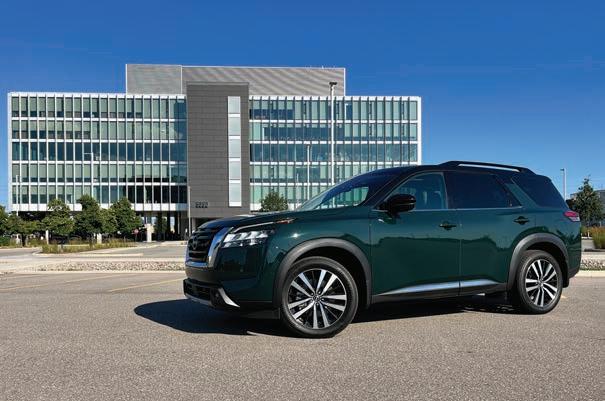
By Ruth Alfson
With the push for fleets to make a transition from the internal combustion engine (ICE) vehicles to electric vehicles (EV), organizations may find themselves adding EVs to meet sustainability quotas or regulatory requirements. Transitioning to EVs can be an expensive proposition if not carefully considered and planned for. Adding an EV to the fleet involves more than just purchasing it and using it. There are three general questions that you need to ask before planning for the transition:
How am I going to charge the electric vehicles?
How will they fit into my fleet?
How much will they cost over time?
While these questions appear to be simple, the answers have serious implications for the cost of fleet operations and must be accounted for in a detailed transition plan.
First, before contemplating which vehicle should be added to your fleet, you need to have a plan for charging it. Planning costs less than construction. A good plan should save thousands of dollars when it comes time to install infrastructure because everything was thought out beforehand. In addition,
the planning stage for the infrastructure is the perfect time to explore rebates or grants from local electricity providers that may offset some of the capital outlay needed for the infrastructure. In addition, many federal or provincial agencies offer grant programs to companies to install charging infrastructure to encourage EV adoption strategies. Purchasing a vehicle without thinking about the infrastructure can be a costly proposition. It is not as simple as buying a charging unit and installing it in a convenient place. You need to know how many vehicles you will potentially need to charge, how you are going to track the charging data, and whether the actual site for the charger can handle the electrical load. This means you need to sit down and create a plan for the infrastructure. This plan not only needs to address your immediate charging needs, but how it can expand as more EVs are added. The plan should include sections on where the charging units will be installed, the capacity of the energy that gets delivered to the site, any construction that needs to take place to add the charging infrastructure, the charging network software, and ongoing maintenance of the charging
hardware. Too many organizations rush to install one or two chargers to accommodate vehicles already procured and then must remove them because of expansion and improper planning.
Second, buying an EV just to promote greener technology can potentially cost more than anticipated. Some organizations purchase an EV to demonstrate environmental responsibility without considering if the vehicle can perform its intended function. If the vehicle cannot do the job, it is an expensive asset to have sitting in a parking lot unused. In a recent example, we witnessed an organization that had purchased several electric Smart cars for their water inspectors. These vehicles were quickly sidelined as the inspectors had to each transport a five-foot-long tool designed to open manhole covers. The tool did not fit in the vehicle. The vehicles were reassigned to a motor pool where they sat mostly unused as they were too small for most administrative functions. This proved to be a costly mistake for the organization.
It is better to evaluate fleet needs and compare them to what EV

options are available in the marketplace and only select vehicles that are fit for purpose. We recommend an evaluation of the job the employee is performing and the purchase of an EV that not only is job-appropriate but meets the sustainability goals of the organization.
After considering potential use cases for EVs, you should consider how much it will cost over time. The Total Cost of Ownership (TCO) for the specific vehicle under consideration will provide all costs associated with acquiring, owning, and operating the asset. What does the TCO include? It starts with the original purchase price, taxes, licensing, and any other costs associated in placing the vehicle in your fleet, even if it is never driven. This may include credits or rebates for EV purchases that can reduce the initial purchase price or offer a tax savings.
Next, you must consider the costs to maintain the vehicle over its life. Normal items like tires and wiper blade replacements are the same whether the vehicle is powered by gas or electric. The difference in maintenance comes when you understand that EVs do not incur the expenses related to oil changes, tune-ups, coolant, trans-
mission services, belts, plugs, and so on. As these services are not going to be needed, the maintenance costs over the life of the unit will not be as high as those for gas powered vehicles.
Fuelling the vehicle is essential whether it is electricity or gas. Understanding how much it will cost to charge a vehicle based on the price paid for electricity can be a factor. Currently, the average price for a litre of gasoline in Canada is $1.62. For a vehicle that holds 56.78 litres of gasoline ($91.98) and gets 10.62 kilometres per litre
in a city environment, the vehicle can travel 603.50 kilometres. $91.98 divided by 603.5 kilometres equals approximately $0.152 per kilometre.
Conversely, if an electric vehicle has a 66 kWh battery that has a range of 603.5 kilometres, the calculation can also be made if you know how much you are paying per kWh for electricity. If you pay $0.25 per kWh, then $0.25 times 66 equals $16.50. Therefore, $16.50 divided by 603.5 kilometres equals approximately $0.027 per kilometre.
Keep in mind that the calculations for electricity cost per kilometre do not include any fees you might pay to use a public charging station, or the cost of the infrastructure if you install it at your office location. But the savings can more than offset these costs over the long term if the right vehicle is chosen for the job and an infrastructure plan is in place that allows for a future expansion done in the right way.
As your organization considers the integration of electric vehicles in their fleet, remember that the dif-
Purchasing a vehicle without thinking about the infrastructure can be a costly proposition.
ference between a costly venture or an efficient alternative to ICE vehicles is planning. By carefully selecting the vehicles to be transitioned, developing the needed charging infrastructure, and understanding the TCO of electric replacements, fleet professionals can ensure a smooth and efficient path to a greener fleet. FM/S
By Matthew Betz
Employees leave their employers for any number of reasons. The employee may feel like their personal beliefs aren’t a fit for the employer’s culture. An employee may resist an organizational change, like the move to EVs, or structural changes in the organization. And beyond the loss of job satisfaction, over my years in fleet, I’ve heard of drivers changing jobs simply because the new employer offered a better company vehicle.
Employee retention may not seem like a fleet issue, but turnover can cause frustration for fleet managers. It can cost hundreds of thousands of dollars to replace an employee that drives a company vehicle when that driver is involved in a sales or service function. Every driver who leaves can mean lost sales, missed service commitments, training a replacement and lost revenue while a new employee gets up to speed.
Fleet departments experience problems with employee turnover that the rest of the organization may not be aware of. For instance, a vehicle garaged at the driver’s residence must often be picked up and moved into storage, or to another employee in need of a vehicle. That can include valuable samples, tools or other goods kept in the vehicle. The vehicle often needs to be relicensed and the new driver must pass back-
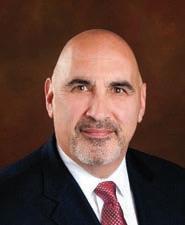
1. 2.
ground checks and motor vehicle record checks as well as acknowledging they have completed driver safety training.
While fleet departments may not have full authority to initiate fixes, they can ensure they bring possible solutions to management, or at least ensure that fleet programs aren’t causing employee turnover. To better understand this issue, I turned to my daughter, Dr. Alison Betz of ABA Technologies, and gained insights into the human side of turnover and ways to keep employees engaged and productive.
There are different approaches to internal customer service, and some are better for driver retention than others. I know, and have spoken with, good fleet managers that feel the “driver is the enemy” and the internal customer is the driver’s management. But most fleet managers see the driver as their internal customer and want to keep them happy, safe, and productive.
What can fleet professionals do to improve driver retention? Here are several key points that I learned from Dr. Betz. First, organizations must understand the reasons for turnover so a driver retention strategy is most effective.
Drivers want training and to feel supported. By talking to drivers and learning where they feel they may
need more training, fleet managers can work with vendors to provide education that meet driver needs and schedules. Many fleet safety programs deliver training in short, easily digestible segments delivered as close as possible to an unsafe driver action. This may need coordination with training and telematics providers, but once implemented can be highly automated.
Drivers want to feel supported. In dispersed, national fleets, the key source of driver support is often the field supervisor. For example, a telematics report showing risky driver behaviour is sent to the field supervisor who is then expected to speak with the driver to help change the behaviour. We often hear from supervisors that they haven’t been trained to have these sensitive conversations. If you expect to improve driver retention, and keep them safe, it’s imperative that you train field supervisors to have impactful conversations with drivers.
We’ve learned that drivers often respond positively to “gamification.” Where possible, use gamification that gives positive reinforcement to behaviours you want to reward. A lesson I’ve learned from my expert daughter is, positive reinforcement can be more powerful than negative action. Sales teams are often very competitive and can be targets for gamification, but the concept works with most employees.
Another concern for drivers is major process or program changes, like moving to EVs. If your organization has a change management department, get them involved. If not, consider a pilot program to allow you and your drivers to learn through experience. Pilots can build driver confidence in the new program and build a group of supporters that can become evangelists. Drivers that share their positive experience with the new program can motivate others. A pilot also lets you identify gaps and build solutions that other drivers are more likely to accept.
Aside from new programs you may be introducing, try an on-going evaluation of how well your program is meeting driver needs. Are you doing everything possible to support them? Do you employ a maintenance management program, collision management, fuel cards, license renewals, and other services they require? A driver council or advisory board can gain these insights, but don’t overlook one-on-one conversations.
Finally, communicate your program’s successes and the high level of driver satisfaction. Drivers can be isolated from the rest of the organization and often don’t understand why things happen. Communicating those successes helps them become better customers to your fleet program. FM/SP




Driving your team towards their goals?


That’s something we definitely have in common. Our safe, adventurous vehicles help them carve their path to success, while our expert service and high resale value let you redefine the impact of your fleet. We share a vision, let’s get there together.

































































Full-time all-wheel drive for full-time confidence in motion. Superior drivability, outstanding control and handling you can count on.
Innovative advance warning safety system that helps you avoid potential danger on the road. Subaru’s eye on safety1
1. EYESIGHT® is a driver-assist system which may not operate optimally under all driving conditions. The driver is always responsible for safe and attentive driving.System effectiveness depends on many factors such as vehicle maintenance,and weather and road conditions.See Owner’s Manual for complete details on system operation and limitations.2.SUBARU STARLINK® Connected Services are offered on an initial three-year free subscription on select trim levels.Customers are required to enroll in the SUBARU STARLINK® Connected Services program.To operate as intended,SUBARU STARLINK® Connected Services require a sufficiently strong cellular network signal and connection.See your local Subaru dealer for complete details.








On-board technology system connecting your Subaru to the world. 24/7 safety and convenience wherever you go2






By Howard J Elmer
3D with the ability to discern between static and moving objects for added layers of blind-spot or bad-lighting situations.
But we have to note that many of these ADAS are available as paid-for options, and only on passenger cars and light-duty vehicles. In fact, in the world of commercial vehicles, very few of these systems are mandatory. Looking at the history of ADAS and vehicle safety in general, advances come before legislation and usually at a price. Hard to believe that at one time seatbelts were an option.
Almost all vehicle crashes are caused by driver error. Through the second half of the 20th Century, that was taken for granted and the government, public, and manufacturers worked diligently to make cars safer for the driver and passenger in the event of a crash. Seat belts, crumple zones, airbags, safety glass, baby seats – the list goes on. And yes, these advances in safety systems meant more people walked away, unhurt, from serious crashes. However, these advances continued to accept the fallibility of drivers as unresolvable. Crashes were going to happen – so how do we protect the occupants? That was the only goal, until the rise of the on-board computer. With this change, vehicles got a brain that could now actively try to prevent driver errors that led to those crashes. These new safety measures come under the heading of advanced driver-assistance systems (ADAS).
ADAS are technologies that assist drivers with safe operation. Through a human-machine interface, ADAS uses automated technology, such as sensors and cameras, to detect nearby obstacles or driver errors, and respond accordingly and autonomously.
One of the first widely used ADAS was the ABS (Anti-lock Braking System)– which cut down on out-of-control skids, available more than 40 years ago.
Consider traction control – a system that is widely used and has been around for more than 20 years. I will concede that many times, particularly in snowy conditions, traction control has saved me from the ditch. It responds quicker and with more finesse than I can – it’s a fact. And that’s the point of ADAS today. It can save us from ourselves.
So as computers grow smaller and cheaper, and yet more power-
ful, manufacturers have begun adding them to vehicles to improve efficiency and safety. Modern vehicles are equipped with adaptive cruise control; anti-lock brakes; back-up cameras; forward collision warning; high-beam safety systems; lane departure warning; traffic signals recognition; and traction control, to name just a few.
The reasons these systems work is because the computer is being fed data inputs from sources in and around the vehicle.
This includes automotive imaging, which is a series of highquality sensors that mimic and exceed the capabilities of the human eye in terms of 360-degree coverage, 3D object resolution, high visibility in difficult weather and lighting situations and realtime data. LiDAR (light detection and ranging) adds even more cameras and sensors for computer vision that transform outputs into
The body responsible for monitoring these ADAS advances and recommending mandatory acceptance is Transport Canada. Just two years ago Transport Canada compiled a list and looked at whether some of these features should be required on some new vehicles in Canada, in particular school buses and commercial trucks, while avoiding requirements that could keep the technology from advancing. If required, these features would become standard equipment on new vehicles.
The following are quotes from the Transport Canada report on ADAS being considered, and have been edited for length.
Rear-visibility systems show a driver what’s behind their vehicle when backing-up. These systems are required for light duty vehicles. The systems usually place a camera at the rear of a vehicle and a screen near the driver. There are no requirements for this technology in North America or internationally.
Driver drowsiness or distraction monitoring systems monitor the driver and warn them (using methods that become more intense over time) when signs of drowsiness or distraction are detected. The goal is to re-focus the driver on driving, and in the
case of drowsiness, to alert the driver or suggest they take a break. There are no requirements for this technology in North America.
Camera monitoring systems replace side-view mirrors and use a combination of cameras and video monitors. There are advantages for vehicles fitted with cameras instead of mirrors, like better fuel economy. For heavy vehicles, these systems can improve visibility by reducing the blind spots created by mirrors. In 2016, Transport Canada consulted with manufacturers and Canadians on allowing these systems, but the feedback received did not support the idea. The technology has continued to evolve, and some manufacturers have asked for the systems to be allowed. There are no requirements in North America for this feature, but there are minimum requirements in Europe. In Canada, the use of side view cameras is permitted as long as the vehicle also has conventional side view mirrors.
Blind spot information systems notify drivers when a pedestrian or cyclist is in a possible blind spot and warns the driver if a collision is likely. Transport Canada has done track tests and a yearlong field trial of one type of system installed on different vehicles in Canadian cities. Results of these studies are pending.
Electronic stability control improves steering by automatically braking individual wheels as a way of correcting oversteering or understeering.
The feature is required for light vehicles (passenger cars, pickups, minivans, and multi-purpose passenger vehicles) and heavy vehicles (truck tractors and highway coach buses), but not for medium-sized vehicles (tow-trucks, dump trucks, garbage trucks, and delivery
Many times, particularly in snowy conditions, traction control has saved me from the ditch.
trucks). This is partly due to the wide range of vehicle designs and configurations. This feature is required on medium vehicles in Europe (UN Regulation 13).
Some studies have found that drivers don’t always fully press the brake pedal in an emergency. Emergency brake assist systems apply extra braking force when panic braking is detected. This can lead to shorter braking distances and fewer collisions. Automatic emergency braking works similarly by sensing objects and could be considered as the next evolution
of this system. There are no requirements for this technology in North America or internationally.
ADAS will no doubt continue to evolve and that’s a good thing. But it is ultimately government that will have to make these systems mandatory and move them from the “options” list. Preventing crashes and injuries should be the goal in every type of vehicle and universal adoption of ADAS is the way that will happen. FM/S
By Stephanie Wallcraft

Automakers love touting their latest and greatest, but newer isn’t always better in every application.
The three-row SUV segment is a great example. Today, you’ll find larger ones, smaller ones, hybrids, and plug-in hybrids, and even an EV or two. But as with everything these days, car prices are creeping upward. Once you crunch the numbers, and depending on usage, the reduced fuel costs from choosing an electrified vehicle don’t always make up for the higher upfront expense. This is especially true if you have mechanics on staff who aren’t yet trained in maintaining hybrid and electric components.
Mid-size three-rows with a low-fuss, trusty V6 are getting harder to come by. Among those that are left, the Nissan Pathfinder is a solid choice. It’s priced affordably, and while it doesn’t come with the latest bells and whistles like electric motors and expansive screens, it does do certain functional things well.
Standard all-wheel drive, heated front seats, and a heated steering wheel have become all but the default in this segment, but Nissan throws in three-zone climate control, blind spot monitoring and intervention, and rear cross-traffic
alert on its base S trim. This is in addition to other standard safety features like forward collision warning, lane departure warning, automatic high beams, and Nissan’s ProPilot Assist hands-on highway driving assistance technology. The 2024 Nissan Pathfinder also rates as an IIHS Top Safety Pick+, which is no small feat under the institute’s updated and more rigorous testing regimen. A panoramic moonroof is included from the SV trim and up, one level above base.
On the other hand, the Pathfinder’s standard 8-inch or available 9-inch infotainment screens are smaller than average, and you’ll need to climb to at least the
SL trim to connect to Apple CarPlay and Android Auto without a cable. Cargo measurements of 470 litres behind the third row, 1,274 litres behind the second row, and 2,280 behind the first row are average but not exceptional. There’s a seven-seat configuration with a removable centre console and a pair of captain’s chairs that will pull forward while keeping a car seat in place, but this setup is only offered on the top Platinum trim. All other trims come with bench seats and seating for eight. The rear seats are on the tighter side – we had teenagers piled in there for a short trip without complaint once the second-row passen-
1. The Pathfinder has standard 8-inch or available 9-inch infotainment screens, and the SL trim connects to Apple CarPlay and Android Auto without a cable.
2. The Pathfinder has a seven-seat configuration with cargo measurements of 470 litres behind the third row, 1,274 litres behind the second row, and 2,280 behind the first.
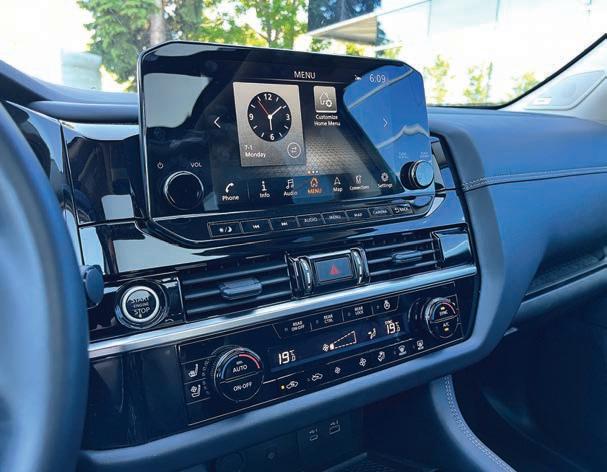
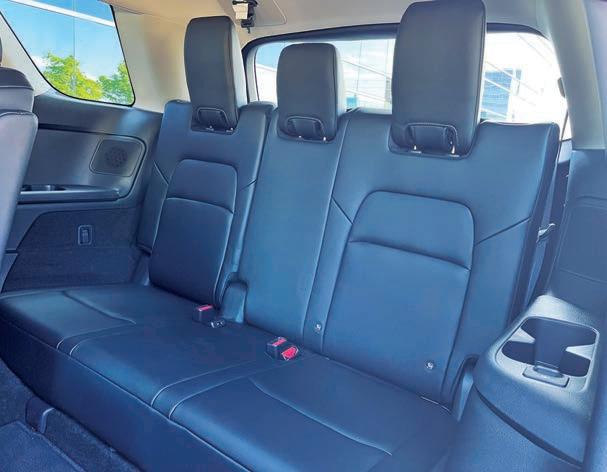
gers gave up some leg room, but adults will likely find it unpleasant back there for longer trips.
The naturally aspirated 3.5-litre V6 under the Pathfinder’s hood produces 284 horsepower and 259lbs-ft of torque. More important is the nine-speed automatic transmission, which has a much more pleasant drive feel than the previous-generation Pathfinder’s continuously variable transmission (CVT). The nine-speed helps the V6 move through lower speeds quickly and smoothly, making up for the engine’s lack of turbocharger to get this nearly 2,110kgs (4,650lbs) SUV under way relatively swiftly.
Canada, you can expect the 2024 Pathfinder to return fuel consumption figures of 11.7 litres per 100km in the city, 9.3 on the highway, and 10.6 combined. Among gas-powered, non-electrified vehicles in this class, this figure is better than average and beats competitors such as the Hyundai Palisade, Kia Telluride, and Honda Pilot. For perspective, though, a Toyota Highlander Hybrid costs roughly the same and averages 6.7L/100km combined, though the latter’s drive feel, interior space, and technology are less enjoyable all around than those of the Pathfinder.
One area where the Pathfinder stands out is in towing capacity. With the ability to pull up to 2,720kg (6,000lbs), the Pathfinder offers the best tow rating in its class. This capability is equipped on all versions except the base trim, which is limited to 1,587kg (3,500lbs).
While it may not come with flashy widescreens or the latest powertrains, the Nissan Pathfinder continues to have its place among mid-size three-row SUVs. Fleet buyers are likely to find it appealing as a relatively affordable, functional, and low-fuss three-row SUV. FM/SP
The 2024 Nissan Pathfinder also rates as an IIHS Top Safety Pick+, no small feat under the institute’s updated and more rigorous testing regimen.
As Tested (2024 Nissan Pathfinder Platinum)
Price (including freight and PDI and dealer fees): $61,078
Engine: 3.5-litre V6
Power: 284hp, 259lbs-ft
Transmission: 9-speed automatic
transmission
Rated Fuel Economy (L/100km): 11.7 city/9.3 hwy/10.6 combined
Observed Combined Fuel Economy (L/100km): 11.3
Recent cases reflect an increase in inside advantage and biased specification cases in Canadian public procurement, particularly when purchasing institutions fail to properly manage their external consultants. While this is not a new issue, these new rulings underscore the importance of implementing proactive conflict of interest safeguards to prevent unfair bidding practices.
Unfair inside advantage is not limited to public sector tendering. In fact, these types of conflicts can undermine the integrity of both public and private sector bidding. For example, in its April 2021 decision in Di Sarra v. Ontario Assn. of Architects, the Ontario Superior Court of Justice – Divisional Court dismissed an appeal from a decision of the Discipline Committee of the Ontario College of Architects which found an architect guilty of misconduct due to a conflict of interest. The architect was found to be in a conflict of interest because he provided millwork drawings used by his private client to solicit quotes for a home renovation and at the same time acted as the owner of a company that submitted a quote for that same work. The discipline committee found that this conduct breached the professional regulations that prohibit an architect from submitting bids or tenders on a project when that architect is also providing architectural services for that same project. This case serves to further underscore the importance of maintaining a clear division between those who work on behalf of an owner on a project and those who work for parties who are bidding on that same project.
Moving to the federal public sector sphere, in its August 2021 determination in Visiontec (2008) Ltd. v. Canada (Department of Public Works and Government Services), the Canadian International Trade Tribunal upheld the federal government’s decision to disqualify a bidder due to an apparent conflict of interest. The Tribunal found that the government was not aware of the potential conflict when, on the recommendation of the complainant, who would later submit a bid for the project, it hired an individual, referred to as “DE” in the ruling, to assist in preparing the RFP, while that individual was concurrently retained by the complainant as a consultant. DE did not notify the government of the potential conflict until October 2020, at which point he had already been working on the RFP as a government employee for about a month. The Tribunal found that prior to ultimately resigning from the government in December 2020, DE contributed to the development of the RFP statement of work, evaluation criteria, and scope definition, which gave him access to information that was not available to other bidders. Given the paramount importance of eliminating unfair advantage to protect the integrity of the procurement process, the Tribunal determined that even the appearance of a conflict was sufficient to justify the disqualification.
Even more recently, in its June 2023 report entitled Report on the Rehabilitation of the Roussin Centre (Calls for Tenders IMM SP20-
05, IMM22-01 and IMM22-08), Montreal’s Inspector General found that two municipal tender calls for a community centre upgrade project included biased specifications and that those tender calls did not include a required clause allowing potential bidders to submit equivalency requests during the pre-bid tender posting period. As the Inspector General noted, the applicable legal standards required the municipality to prepare specifications that were described in terms of neutral performance or functional requirements rather than descriptive characteristics and, if that was not possible, required that bidders be permitted to propose equivalencies.
However, the Inspector General found no evidence that the consultant retained by the municipality to draft the requirements had attempted to prepare neutral specifications before adopting specific brands and models into those specifications. The Inspector General concluded that the consulting contract in question should be rescinded, and that the municipality should develop a plan to better ensure that future specifications are prepared in a manner that is compliant with applicable neutrality standards. The Inspector General also prescribed mandatory training for all municipal employees involved in the design and preparation of tender documents and instructed that those employees responsible for managing external technical consultants advise those consultants of applicable neutrality standards at the beginning of each project.

Paul Emanuelli is the general counsel of The Procurement Office and can be reached at paul.emanuelli@ procurementoffice. com.
“The failure to manage external consultants can undermine the integrity of a bidding process.”
As these cases illustrate, the failure to manage external consultants can undermine the integrity of a bidding process. To comply with their fair process duties, public institutions should establish measures to screen for potential conflicts and implement procedures to preclude those who participate in the preparation of solicitation documents from bidding on those same opportunities or from introducing biased specifications into tender call requirements. SP
Reach and communicate directly with Canada’s supply chain and procurement professionals with


Grow the readership for your content through SUPPLYwire . Your content posts will be broadcast and delivered to supply chain and procurement professionals through Supply Professional magazine’s proven digital editorial content channels!
You can post ANY TYPE OF CONTENT to SUPPLYwire for full market distribution, including:
> Press Releases and News Announcements
> Appointment Notices
> Content Articles of Any Nature
> Product Reviews
> Technical Articles
> Sponsored Content
> White Papers
> Blog Posts (reposted from your site or blog)
> Video/Multimedia Posts (embedded) And much more...
We make it easy to post your content! Send us your content elements (text, photos, logos, etc.) and we’ll produce a content post proof for your review and approval.
Rates: Individual Post @ $595/Net Per Annual Package @ $4,165/Net Per [Includes 10 Postings Per One (1) Year]
For further information or to have your content posted and distributed to our audience, please contact: Faria Ahmed: faria@supplypro.ca


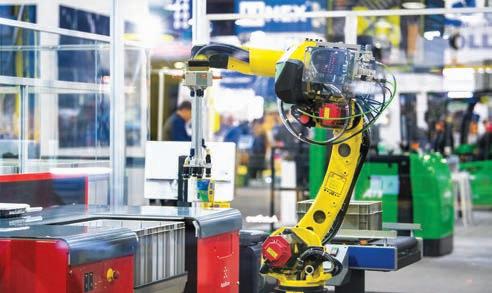
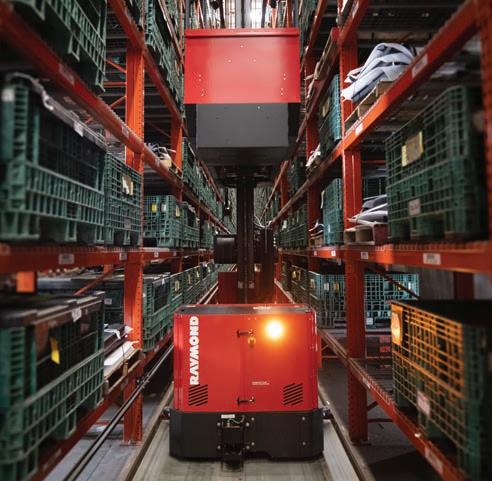
Build smart. Stay agile. Now is the time to take a broader look at your overall intralogistics strategy and optimize. Making adjustments to combat today’s challenges will prepare you for a strong and sustainable future. And we can help.
Together, we’ll analyze the strategy and systems you’ve built to move, manage, store and protect goods and bring forward new ideas to enhance or secure the investments you’ve already made. Let’s get started.